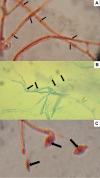Mycelial compatibility, anastomosis, and nucleus numbers of eight Mexican Hirsutella citriformis strains isolated from Diaphorina citri
- PMID: 33976961
- PMCID: PMC8061572
- DOI: 10.7717/peerj.11080
Mycelial compatibility, anastomosis, and nucleus numbers of eight Mexican Hirsutella citriformis strains isolated from Diaphorina citri
Abstract
Background: Among entomopathogenic fungi, H. citriformis has been recognized as potential biocontrol agent against the Asian citrus psyllid Diaphorina citri (Hemiptera: Liviidae). Nevertheless, this fungus is poorly characterized. Previous molecular studies have shown high sequence similarities among strains, but significant differences in Diaphorina citri virulence.
Objective: The aim of the present study was to determine mycelial compatibility and anastomosis, and nucleus numbers in mycelium and conidia of eight H. citriformis strains isolated from mycosed D. citri adults collected from several Mexican states.
Methods: Mycelial compatibility and anastomosis evaluation was performed after pairing strains, leading to 36 confrontations, and cultured in chlorate minimum medium to obtain mutants for vegetative compatibility group.
Results: Hypha or conidia nuclei were visualized with safranin-O and 3% KOH, and 0.05% trypan blue-lactophenol solution. H. citriformis strains showed compatibly and anastomosis events after confrontation. In addition, they showed one nucleus per conidium and mycelium section. It was not possible to obtain H. citriformis nit mutants from the chlorate concentrations tested.
Conclusions: To date, this is the first report demonstrating mycelial compatibility, anastomosis occurrence, and hyphae and conidia nuclei number among H. citriformis strains.
Keywords: Fungus mexican native strains; Mycelial characterization; Nit mutants; Nuclei.
©2021 Pérez-González et al.
Conflict of interest statement
The authors declare there are no competing interests.
Figures





Similar articles
-
Insight into Biological Control Potential of Hirsutella citriformis against Asian Citrus Psyllid as a Vector of Citrus Huanglongbing Disease in America.J Fungi (Basel). 2022 May 27;8(6):573. doi: 10.3390/jof8060573. J Fungi (Basel). 2022. PMID: 35736056 Free PMC article. Review.
-
Adult Diaphorina citri Biocontrol Using Hirsutella citriformis Strains and Gum Formulations.Plants (Basel). 2023 Sep 6;12(18):3184. doi: 10.3390/plants12183184. Plants (Basel). 2023. PMID: 37765348 Free PMC article.
-
Improved Diaphorina citri (Hemiptera: Liviidae) Adults Biocontrol in Citrus by Hirsutella citriformis (Hypocreales: Ophiocordycipitaceae) Gum-Enhanced Conidia Formulation.Plants (Basel). 2023 Mar 22;12(6):1409. doi: 10.3390/plants12061409. Plants (Basel). 2023. PMID: 36987097 Free PMC article.
-
Morphological and molecular characterization of a Hirsutella species infecting the Asian citrus psyllid, Diaphorina citri Kuwayama (Hemiptera: Psyllidae), in Florida.J Invertebr Pathol. 2007 Jun;95(2):101-9. doi: 10.1016/j.jip.2007.01.005. Epub 2007 Feb 3. J Invertebr Pathol. 2007. PMID: 17382959
-
Isolation, fermentation, and formulation of entomopathogenic fungi virulent against adults of Diaphorina citri.Pest Manag Sci. 2021 Sep;77(9):4040-4053. doi: 10.1002/ps.6429. Epub 2021 Jun 1. Pest Manag Sci. 2021. PMID: 33896118
Cited by
-
Insight into Biological Control Potential of Hirsutella citriformis against Asian Citrus Psyllid as a Vector of Citrus Huanglongbing Disease in America.J Fungi (Basel). 2022 May 27;8(6):573. doi: 10.3390/jof8060573. J Fungi (Basel). 2022. PMID: 35736056 Free PMC article. Review.
References
-
- Akram A, Iqbal SM, Ahmed N, Iqbal U, Rauf A. Morphological variability and mycelial compatibility among the isolates of Sclerotinia sclerotiorum associated with stem rot of chickpea. Pakistan Journal of Botany. 2008;5:11–15.
-
- Aubert B. Trioza erytreae Del Guercio and Diaphorina citri Kuwayama (Homoptera: Psylloidea), the two vectors of citrus greening disease: biological aspects and possible control strategies. Fruits. 1987;42:149–162.
-
- Brooker NL, Leslie JF, Dickman MB. Nitrate nonutilizing mutants of Colletotrichum and their use in studies of vegetative compatibility and genetic relatedness. Phytopathology. 1991;81:672–677. doi: 10.1094/Phyto-81-672. - DOI
LinkOut - more resources
Full Text Sources
Other Literature Sources

